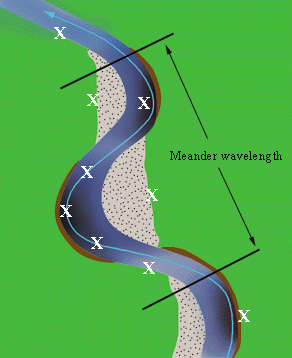|
|||||||
|
Sure! The discharge determined on the prior page is a little less than 0.9 cubic meters per second. The calculation was very easy: a product of cross sectional area and average velocity. But that's for our hypothetical stream with a rectangular cross-section and uniform velocity from bank to bank. Real-world streams are not that simple. Cross sections are irregular and a stream's flowing water is slowed by the frictional effects of the sides of the channel.
The left illustration below has two straight lines that cross the stream at meander bends. The distance between those lines is called the meander wavelength. Riffles (where the channel is straight) and point bars (on the inside of a meander curve) are places where sediment is being deposited and temporarily stored. Pools are places where sediment is being eroded or removed. Move your mouse cursor over the points marked "X" to find descriptions of some of the features of a meandering stream.. Then respond to the questions below by matching the red letter with its corresponding term.
|
|||||||
|
Copyright © 2000-2019 Virtual Courseware Project |
|||||||




